The herd grazes on the high desert plains, snatching mouthfuls of grasses if there are any. When they are thirsty, they are generally thirsty as a group, because the water hole may be some distance from where they are grazing.
One horse may raise his head from the ground, listening to some sound in the distance. Even if the others are far away, they will know the one horse has done this. They will also raise their heads, and turn them in the direction the first horse is looking.
If there is a weak horse among them who can improve, a herd member will walk with him and pick a gait that the other horse can accomplish, helping the weak horse find that strength and rhythm in his own body.
The young ones are corrected by the dams and by the older horses, and are rounded up when the herd moves on. Some may straggle, but eventually run to catch up with the herd. The young ones are often herded by the others to make sure they don’t fall behind or get distracted. This is how they learn to stay with the group, and not falter, and not get into trouble.

They walk single file and side by side to their next destination. They are equipped with a strong sense of smell that allows them to detect changes in the wind, and smell water. They can also feel vibrations through the ground to know when other animals or humans are near, when a snake is in the grass.
This way of being is still part of all horses, even the most domesticated ones. Our most successful training of horses comes from knowing what horses need and how they interact with each other to maintain their safety.
A wild herd is not very different from a domesticated herd, which comes together from circumstances beyond their control. They still follow the same practices, still walk single file and walk side by side. They still herd each other and will help along a weak horse. They still can communicate from across a field.
 The movement of an ear, a look, is all it takes to move the individual or the entire herd. Behavior that threatens the larger group will be disciplined, sometimes by banishment, sometimes just for a short time, sometimes forever.
The movement of an ear, a look, is all it takes to move the individual or the entire herd. Behavior that threatens the larger group will be disciplined, sometimes by banishment, sometimes just for a short time, sometimes forever.
The eyes are also very subtle in their movements. Horses don’t necessarily have to move their heads to acknowledge the presence of another horse or person, they can simply roll their eye back and they see.
The ideas humans have come up with to train horses, in most cases, bear no resemblance to what horses would do on their own. The round pen, tying a leg up to keep a horse from bucking, waving flags or ropes in their faces or hitting them in the face, are all pressure-based trainings that are purely manmade and have no basis in cooperative horse behavior. Horses are sometimes brutal with one another, but unless we want that behavior to be part of our interaction with the horse, it is not a good place to start.
Cooperative horsemanship in the form of Liberty Foundations may take longer than traditional methods of

horsemanship. With this work we are waiting for a connection, which may start out as a weak signal, but sometimes comes on very eager and strong. Whichever you get, the time it takes to build this connection is worth its weight in gold. In the beginning, a student may have a really good day where the connection feels very deep and strong, and another day where it feels like there is no engagement at all. Best not to take any of it personally.
It may look boring or unexciting to some people who expect a show, entertainment. The changes in horses learning Liberty Horsemanship are subtle, but if you were to watch them interact on their own, they could probably seem boring too.
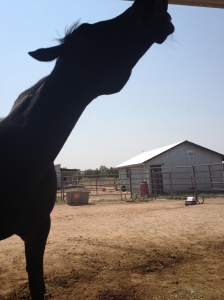 My advice to anyone embarking on this study is to stick with it. When you have a boring or seemingly unproductive day where the horse seems uninterested in engaging, just sit with it, sit with the horse. You sit with a sick relative, a child who is more interested in his drawing or friends than you. Try doing it with a horse.
My advice to anyone embarking on this study is to stick with it. When you have a boring or seemingly unproductive day where the horse seems uninterested in engaging, just sit with it, sit with the horse. You sit with a sick relative, a child who is more interested in his drawing or friends than you. Try doing it with a horse.
Remember, we are doing this without an agenda. If you’ve trained your horse with a round pen, you have gotten results quickly, because the horse quiets down or complies, but he is not really in relationship with you. “Joining up” or whatever you want to call it, is achieved because the horse has nowhere else to go in that dynamic. You are calling all the shots in that setting.
When we work without an agenda, which is difficult for humans, we place no value on the outcome. When we receive an outcome that pleases us we can be pleased, but don’t expect it the next day or the next. When we work without agenda in a space big enough for the horse to get away, he has a sense of freedom. It may take him awhile to realize that you are there, in the same space, not expecting anything of him, and he can make choices.
Very often, what you think is non-productive with a horse, turns out to be very productive.
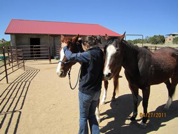 In my bodywork practice, what I learned early on was that horses use each other to heal. They also use space and time to heal. When I have a horse that needs a certain move on a part of her body, but is very resistant, I may go to another horse and see if that one would like the move done. If I have permission to work on the second horse, then I do what I would’ve done on the first horse. The first horse invariably releases the area that has been troublesome and where she couldn’t tolerate direct contact.
In my bodywork practice, what I learned early on was that horses use each other to heal. They also use space and time to heal. When I have a horse that needs a certain move on a part of her body, but is very resistant, I may go to another horse and see if that one would like the move done. If I have permission to work on the second horse, then I do what I would’ve done on the first horse. The first horse invariably releases the area that has been troublesome and where she couldn’t tolerate direct contact.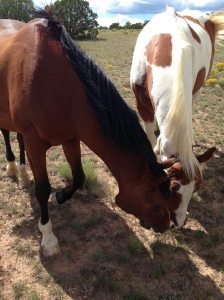
One of the beautiful things about doing distance bodywork is that I am shown in a slightly different way where and how to address the body. If a horse can communicate to another horse across a field, then she can communicate with you, if you are open to it, many miles away. No distance is too great.
When I work with my horses free in a big pasture, they may run for awhile, seem to ignore me while grazing, but they come back to me, joyfully. They are aware of my presence the whole time. We are tethered to one another by invisible threads of connection.
Why I bring these things up is because there is universal communication between all of us, but I believe people for the most part, have lost touch with it and seek quick, easy solutions. Actually, there is ease in this way of relating, but it is not widely practiced.
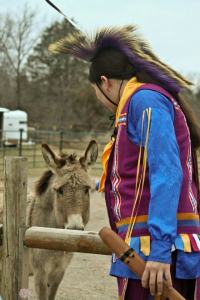 Years ago, a friend who worked with a Native American tribe and lived on a pueblo for some years, told me that communication among the native people she lived with was largely unspoken. In their day-to-day lives they would “feel” what each other was thinking. This is a close-knit tribe with the comforts of knowing each other very well, and knowing where each came from. This is a culture rich in storytelling, which is spoken and carried down to the next generation, but they also have this almost telepathic way of relating as well.
Years ago, a friend who worked with a Native American tribe and lived on a pueblo for some years, told me that communication among the native people she lived with was largely unspoken. In their day-to-day lives they would “feel” what each other was thinking. This is a close-knit tribe with the comforts of knowing each other very well, and knowing where each came from. This is a culture rich in storytelling, which is spoken and carried down to the next generation, but they also have this almost telepathic way of relating as well.
It feels to me like this is close to what horses experience with each other, and what they can grow to experience with us, if we take the time to learn their language.
More on senses can be found in these two blogs:
Working with all six senses and horses
The importance of touch in horse work
****
(copyright: Susan Smith, OrthoHorse)
Services: Bodywork (Ortho-Bionomy for people, Equine Ortho-Bionomy): private sessions, tutorials, phone consultations, Horse & Rider sessions, distance healing communication and gift certificates
Liberty Coaching: clinics, mini-clinics, workshops, private and semi-private sessions, tutorials, consultations: by appointment: 505.501.2478 or emailing susansmith@orthohorse.info Scheduling now. Contact me for details.
September 6 – One-Day Liberty Horsemanship Clinic. In this clinic you will learn the fundamentals of how to work with a horse at liberty, inspired by equine herd behavior. The way that horses interact with each other maintains cooperative relationships, safety and survival within a herd. No restraints are used – the horse becomes a willing participant. A working relationship is desired, where the horse has choice, and ultimately chooses the human to work with. This work extends and translates to all aspects of horsemanship – online and mounted.
9 a.m.-4:30 p.m. Limit: 8 people, 4 horses. $150 for clinic. $15 trailer in fee. Cancellations: 2 weeks prior to class are non-refundable. For those coming from out of town, arrangements can be made for private lessons or bodywork sessions on Friday, September 5.
September 27-28 – Spirit Horse Ranch Two-Day Liberty Foundations Clinic, Oklahoma City, Oklahoma – Engaging the Hearts and Minds of Horses. Susan Smith and Ruella Yates, co-teaching. Contact me or Ruella at 405-771-4274 (ruella@libertyfoundations.com)
Beginning in October: Liberty Foundations Online classes – beginning and advanced – offered by Susan Smith (October 1-beginning) and Ruella Yates (October 7-advanced), Horses at Liberty Online and Spirit Horse Ranch Online.
December 13-14 – Horses at Liberty Weekend Clinic, DeLand, Florida – Bring your Horse into Deep Working Connection with Liberty Horsemanship. Instructor: Susan Smith. Contact Anne Daimler tdaimler@cfl.rr.com (386-822-4564) Susan at susansmith@orthohorse.info (505-983-2128 or cell 505-501-2478) 9:00-4:30 p.m.
Susan is a member of the Independent Liberty Trainers Network. libertytrainersnetwork.com/



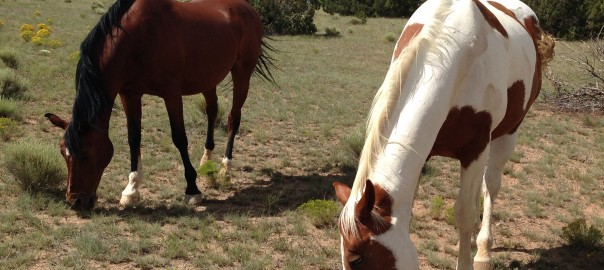
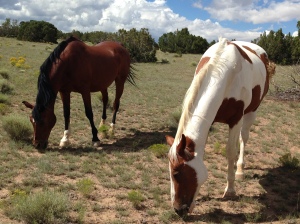
Your blogs are amazing, Susan, and this one about the power which lies in the heart of the herd is one of your best. Thank you!
Ruella Yates
Liberty Foundations
Spirit Horse Ranch
Thank you, Ruella!